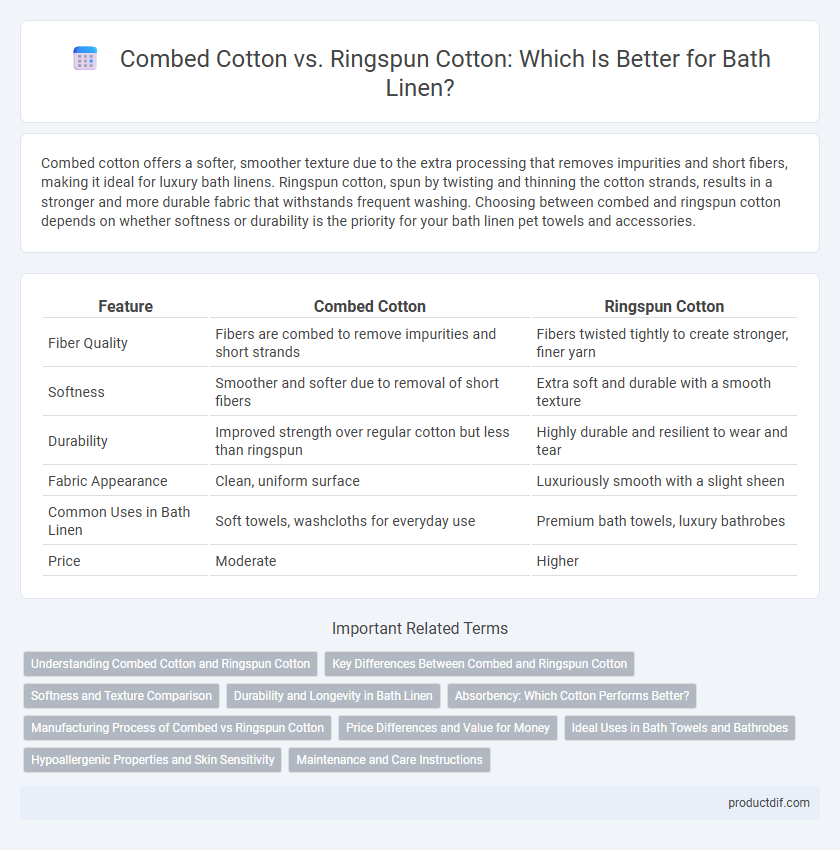Combed cotton offers a softer, smoother texture due to the extra processing that removes impurities and short fibers, making it ideal for luxury bath linens. Ringspun cotton, spun by twisting and thinning the cotton strands, results in a stronger and more durable fabric that withstands frequent washing. Choosing between combed and ringspun cotton depends on whether softness or durability is the priority for your bath linen pet towels and accessories.
Table of Comparison
| Feature | Combed Cotton | Ringspun Cotton |
|---|---|---|
| Fiber Quality | Fibers are combed to remove impurities and short strands | Fibers twisted tightly to create stronger, finer yarn |
| Softness | Smoother and softer due to removal of short fibers | Extra soft and durable with a smooth texture |
| Durability | Improved strength over regular cotton but less than ringspun | Highly durable and resilient to wear and tear |
| Fabric Appearance | Clean, uniform surface | Luxuriously smooth with a slight sheen |
| Common Uses in Bath Linen | Soft towels, washcloths for everyday use | Premium bath towels, luxury bathrobes |
| Price | Moderate | Higher |
Understanding Combed Cotton and Ringspun Cotton
Combed cotton and ringspun cotton differ primarily in their fiber refinement and yarn strength, affecting bath linen quality. Combed cotton undergoes a process that removes short fibers and impurities, resulting in smoother and stronger fabric, ideal for soft and durable towels. Ringspun cotton involves twisting and thinning cotton strands to create finer, stronger yarn, enhancing the absorbency and longevity of bath linens.
Key Differences Between Combed and Ringspun Cotton
Combed cotton undergoes a process that removes short fibers and impurities, resulting in a smoother, softer, and stronger fabric ideal for luxury bath linen. Ringspun cotton is made by continuously twisting and thinning the cotton strands, producing a dense, durable fabric with a slightly textured feel, enhancing absorbency and longevity. The key differences lie in fabric softness, strength, and fiber alignment, with combed cotton offering superior smoothness and ringspun cotton providing enhanced durability for bath towels and robes.
Softness and Texture Comparison
Combed cotton bath linens offer enhanced softness by removing short fibers and impurities, resulting in a smoother, more refined texture ideal for sensitive skin. Ringspun cotton, created through continuous twisting of fibers, produces a dense and durable fabric with a slightly textured feel, balancing softness with resilience. The choice between combed and ringspun cotton bath linens depends on prioritizing ultra-soft comfort versus long-lasting fabric strength.
Durability and Longevity in Bath Linen
Ringspun cotton bath linen offers superior durability and longevity compared to combed cotton due to its tightly twisted fibers, which enhance strength and resistance to wear. The continuous spinning process in ringspun cotton produces a denser fabric that maintains softness even after multiple washes, making it ideal for high-use bath towels and robes. Combed cotton, while soft, has shorter fibers that may degrade faster under frequent laundering, reducing its lifespan in bath linen applications.
Absorbency: Which Cotton Performs Better?
Combed cotton undergoes a special process that removes short fibers and impurities, resulting in smoother, stronger threads with increased surface area, enhancing water absorbency in bath linens. Ringspun cotton, created by twisting and thinning the cotton strands, produces finer, denser yarn that improves fabric softness but may slightly reduce absorbency compared to combed cotton. Studies show that combed cotton bath towels typically absorb moisture more efficiently, making them the preferred choice for maximum water retention.
Manufacturing Process of Combed vs Ringspun Cotton
Combed cotton undergoes an extra step in the manufacturing process where fibers are specially treated to remove short strands and impurities, resulting in a smoother, stronger yarn. Ringspun cotton is produced by continuously twisting and thinning the cotton strands, which enhances durability and softness compared to conventional cotton. These distinct manufacturing techniques directly influence the texture, strength, and quality of bath linens.
Price Differences and Value for Money
Combed cotton bath linen typically costs more than ringspun cotton due to its higher quality fibers, which are softer and more durable. Ringspun cotton offers good value for money by balancing affordability with strength and absorbency ideal for everyday use. Choosing between the two depends on prioritizing either luxurious softness or budget-friendly durability in bath textiles.
Ideal Uses in Bath Towels and Bathrobes
Combed cotton, known for its soft texture and durability, is ideal for luxurious bath towels and bathrobes that require a gentle feel and long-lasting quality. Ringspun cotton, featuring tightly twisted fibers, offers superior strength and absorbency, making it perfect for bath linens that need to withstand frequent washing and heavy use. Bath towels and bathrobes made from ringspun cotton provide enhanced comfort and resilience, ideal for daily use in both home and spa settings.
Hypoallergenic Properties and Skin Sensitivity
Combed cotton bath linen features fibers that are meticulously brushed to remove impurities and short strands, resulting in a softer, smoother fabric ideal for sensitive skin and hypoallergenic benefits. Ringspun cotton involves twisting and thinning the fibers to create a finer yarn that maintains strength while offering enhanced softness and durability, which also supports hypoallergenic qualities by minimizing skin irritation. Both fabrics provide excellent options for those with skin sensitivities, but combed cotton's extra refining process often makes it superior in preventing allergic reactions and irritation.
Maintenance and Care Instructions
Combed cotton bath linens require gentle washing in cold or warm water to maintain softness and reduce pilling, while avoiding high heat during drying is essential to preserve fiber integrity. Ringspun cotton towels benefit from similar care but often tolerate slightly higher temperatures, enhancing durability and long-term absorbency. Both cotton types should be air-dried or tumble-dried on low heat to prevent fiber damage and maintain the plush texture typical of high-quality bath linens.
Combed cotton vs Ringspun cotton Infographic

 productdif.com
productdif.com